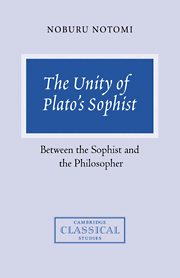Book contents
- Frontmatter
- Dedication
- Contents
- Preface
- Notes and abbreviations
- Division of the Sophist
- 1 How to read the Sophist
- 2 The sophist and the philosopher
- 3 How the sophist appears
- 4 Analysis of the structure of appearance
- 5 Appearance and image
- 6 The sophistic counter-attack on philosophy
- 7 The philosophic defence against sophistry
- 8 The final definition of the sophist
- Bibliography
- Index locorum
- General index
8 - The final definition of the sophist
Published online by Cambridge University Press: 05 June 2014
- Frontmatter
- Dedication
- Contents
- Preface
- Notes and abbreviations
- Division of the Sophist
- 1 How to read the Sophist
- 2 The sophist and the philosopher
- 3 How the sophist appears
- 4 Analysis of the structure of appearance
- 5 Appearance and image
- 6 The sophistic counter-attack on philosophy
- 7 The philosophic defence against sophistry
- 8 The final definition of the sophist
- Bibliography
- Index locorum
- General index
Summary
The art of apparition-making
Now we reach the final attempt to define the sophist, in the second Outer Part of the dialogue (264b9–268d5). Between the two points where the definitional inquiry into the sophist is suspended and resumed, there lies the long digression of the Middle Part (236d9–264b8), which deals with the difficulties concerning what is not and what is (236d9–251a4), the combination of the greatest kinds (251a5-259d8), and the explanation of falsehood (259d9-264b8). We have just clarified how that long argument is constructed with a view to providing solutions to the issues of appearance without being, of image, and of falsehood. In this chapter we shall determine what the final definition of the sophist is, and also illuminate in retrospect what has been done in the Middle Part. Of course, the argument in the Middle Part has much richer philosophical meaning than we discussed in the previous chapter and shall reflect here, but it is only when we examine the whole dialogue, particularly the final definition of the sophist, and assess the significance of the whole scheme, that we can properly understand the meaning of the Middle Part. I shall point out several important results of that argument which contribute to the final definition. Those who concentrate solely on the Middle Part usually dismiss them. This chapter examines the final definition step by step. Particular attention should be paid to its relation to the argument of the Middle Part and to the earlier divisions.
- Type
- Chapter
- Information
- The Unity of Plato's SophistBetween the Sophist and the Philosopher, pp. 270 - 301Publisher: Cambridge University PressPrint publication year: 1999



